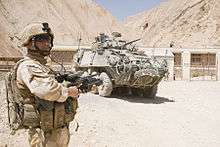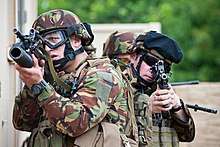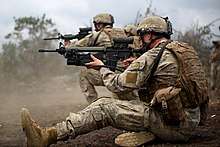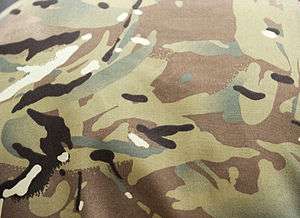New Zealand disruptive pattern material
The New Zealand disruptive pattern material, also known as New Zealand DPM (NZDPM), was the official camouflage pattern on uniforms of the New Zealand Defence Force from 1980 until 2013. It was replaced with a new pattern called Multi Terrain Camouflage[1] (MCU) which was exclusive to the NZDF. This was in turn replaced by the New Zealand Multi Terrain Pattern (NZMTP) from 2020.

New Zealand DPM is derived from British DPM and saw several colour changes before becoming standardized in the 1990s. Dress in this camouflage pattern was worn by all ranks of the New Zealand Army and NZDF for most forms of training and on operations.
Origins
Historically, New Zealand's armed forces used originally British and then Australian-style uniforms, with British battle dress in use until the 1950s and then "jungle greens" as field wear until 1980.
British Disruptive pattern material (DPM) was adopted as the camouflage pattern for clothing of the New Zealand armed forces with the first issues of 1968 Pattern smock and trousers being made in 1980. These were replaced with the first of the New Zealand pattern DPM in 1984, using a winterweight fabric. The heavier fabric plus the dying process changed the original DPM colours, making the green more of a sea green and the tan more of a golden colour. This colourway is considered to be the "first generation" of New Zealand-specific DPM camouflage.
In 1986 a lighter weight fabric was used, the combination of the fabric and dying process changing the colours further, with the green becoming a distinctive "mint" colour and the tan colour becoming even more "yellow." The brown used in the 1986 itineration was a more reddish-brown than previously and would wash out over time to an almost "beetroot" colour.
1997 NZDPM Pattern
From 1994 to 1995 a new variation of colours of the DPM pattern was used, consisting of black, chocolate brown, and olive green shapes on a tan background. The uniforms had problems with colourfastness and so the New Zealand Defence Force issued a brand new uniform in 1997 which resembled the cut of the British "Combat Soldier 95" jungle DPM shirt and trousers. The colours of the 1997 pattern were different again consisting of black, dark brown, and golden-yellow shapes, on a grass green base. These colours remained consistent thereafter.[2] The 1997 uniform was used as field wear until the late 2000s.
2003 New Zealand Desert DPM (NZDDPM)

The first NZDF contingents deployed to Afghanistan wore 1997 pattern NZDPM. A desert version of NZDPM first appeared in 2003 with the deployment to Iraq. The pattern is based on British two-colour desert DPM. Visually the NZDDPM pattern has dithering between the brown and sand colours whereas the British pattern has none.[3]
2008 Uniform update

In late 2008, the New Zealand Army commenced issue of a new combat uniform. It was still in the 1997 NZDPM colours, but made in ripstop material and in a new cut somewhat similar to the U.S Army Combat Uniform. Velcro patches on the arms enable the wearer to display removeable identifying badges, such as the New Zealand flag and the round Kiwi bird emblem, as used in overseas deployments.
A NZDDPM version of the 2008 combat uniform was issued for use in Afghanistan, the Sinai and Lebanon. As of 2014 NZDDPM has been replaced with the New Zealand Multi-Terrain Pattern.
2013 New Zealand Multi Terrain Camouflage (MCU)


On July 27, 2012, the New Zealand Army formally announced new uniforms and a new camouflage pattern for NZDF personnel. It was announced that the new pattern would replace the NZDPM and NZDDPM patterns.[4]
The cut of the new uniform shirt was modernized to be closer to the U.S Army Combat Uniform (ACU) but with pants similar to Crye Precision's Gen 3 combat pant[5][6], typically in use with Special Forces and Police tactical units.
The camouflage pattern is called Multi Terrain Camouflage Uniform (MCU) and is unique to the NZDF. The pattern is a variant of the Ghostex family of camouflage patterns by Canadian company Hyperstealth Biotechnology Corp.[7]
The initial rollout phase for the MCU uniform was concluded on June 16, 2013.[8] The MCU is now the working uniform for all branches and divisions of the NZDF.
After several years of use and some minor style changes, this uniform has proven to be unpopular with soldiers due to weight, sizing, breath-ability and issues with the effectiveness of the camouflage pattern, and is set to be replaced.
NZ SAS
New Zealand Special Forces operating in Afghanistan in the early 2010s wore Australian-issue uniforms in Crye Precision Multicam camouflage, as with Australian, U.S and other allied forces.
Today, NZ SAS generally wear the current combat uniform of the NZDF.[9]
2020 New Zealand Multi Terrain Pattern (NZMTP)

In June 2019, the New Zealand Defence Force announced that NZMTP, a variant of the UK Armed Forces’ MTP camouflage would replace the current issue MCU inform across the armed forces by 2023, citing material sourcing challenges, poor uniform fitting for female service personnel as well as material pattern commonality with Crye Precision’s Multicam camouflage and variants thereof that are used by over 40 countries including military allies such as Australia and the United Kingdom allowing exploitation of current on the shelf military equipment for faster entry to service. [10]
See also
References
- "New Zealand Army selects Hyperstealth/ADS Inc. Camouflage after extensive Field Trials". www.hyperstealth.com.
- http://camopedia.org/index.php?title=New_Zealand
- http://iacmc.forumotion.com/t3848-nz-infantry-afghanistan-c-2009
- "Multi Terrain Camouflage Uniform for New Zealand Troops - Soldier Systems Daily".
- http://i0.wp.com/www.whaleoil.co.nz/wp-content/uploads/2013/06/20130618_OH_D1033071_0008.jpg
- http://www.army.mil.nz/nr/rdonlyres/48914ae1-e2b6-4257-91be-73babc86b8ce/0/oh_d1033071_0009.jpg
- http://blog.predatorbdu.com/2012/07/nzdf-multi-terrain-camouflage.html?m=1
- http://www.nzdf.mil.nz/news/media-releases/2013/20130620nanail.htm NZ Army's New And Improved Look - June 20, 2013
- http://www.nzdf.mil.nz/about-us/nzsof/uaw.htm
- "Army News June 2019" (PDF). Army News. 503: 28. June 2019.
External links
- An example of New Zealand '84 Pattern' DPM
- NZ An later example of New Zealand '84 Pattern' DPM
- Soldiers wearing New Zealand DPM
- New Zealand and Australian camouflage patterns
- New Zealand Army selects Hyperstealth/ADS Inc. Camouflage after extensive Field Trials
| Wikimedia Commons has media related to New Zealand Disruptive Pattern Material. |
.jpg)